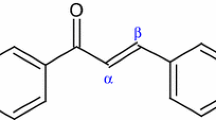Abstract
A series of dihydroflavonol derivatives (4a–4l) were synthesized from chalcones via classical Algar–Flynn–Oyamada (AFO) reaction and characterized on the basis of spectroscopic analyses. All synthesized compounds were evaluated for their inhibitory activity against the pro-inflammatory-inducible TNF-alpha, IL-1beta, and IL-6 in lipopolysaccharide (LPS)-stimulated RAW 264.7 cell lines and showed various efficiency. Furthermore, compounds 4d and 4k were selected to examine their in vivo anti-inflammatory activity by using two classical models. Herein compound 4k showed maximum anti-inflammatory activity of 32.98% inhibition in mice ear-swelling model and 40.06% inhibition at the 2 h intervals in rat paw edema model in comparison to the two references: aspirin and meloxicam. Similar effect was observed at a lower dose. In addition, the compound 4k was docked against cyclooxygenases-2 to validate the attained pharmacological data and provide understandable evidence for the observed anti-inflammatory activity.





Similar content being viewed by others
References
Ayoub IM, Korinek M, Hwang TL, Chen BH, Chang FR, El-Shazly M, Singab ANB (2018) Probing the antiallergic and anti-inflammatory activity of biflavonoids and dihydroflavonols from dietes bicolor. J Nat Prod 81:243–253
Chen CX, Chen JY, Kou JQ, Xu YL, Wang SZ, Zhu Q, Yang L, Qin ZH (2015) Suppression of inflammation and arthritis by orally administrated cardiotoxin from Naja naja atra. Evid-Based Complement Altern Med 2015:387094
Cooke JP, Ferrari M (2018) Inflammation-targeted vascular nanomedicine. Nat Biomed Eng 2:269–270
Devi KP, Malar DS, Nabavi SF, Sureda A, Xiao JB, Nabavi SM, Daglia M (2015) Kaempferol and inflammation: from chemistry to medicine. Pharmacol Res 99:1–10
Ding T, Wang SF, Zhang XY, Zai WJ, Fan JJ, Chen W, Bian Q, Luan JY, Shen YL, Zhang YD, Ju DW, Mei XB (2018) Kidney protection effects of dihydroquercetin on diabetic nephropathy through suppressing ROS and NLRP3 inflammasome. Phytomedicine 41:45–53
Hu CL, Zhou ZB, Xiang YH, Song XY, Wang H, Tao KQ, Ye XC (2018) Design, synthesis and anti-inflammatory activity of dihydroflavonol derivatives. Med Chem Res 27:194–205
Jiang WJ, Ishiuchi KI, Furukawa M, Takamiya T, Kitanaka S, Iijima H (2015) Stereospecific inhibition of nitric oxide production in macrophage cells by flavanonols: synthesis and the structure–activity relationship. Biorg Med Chem 23:6922–6929
Karim AM, Nosiba K, El-Rahman FA, Suad A (2016) Antimicrobial dihydroflavonol from Sudanese Croton zambesicus Muell. Arg. (Euphorbiaceae) seeds. Int J Adv Res 4:1779–1785
Laskowski RA, Swindells MB (2011) LigPlot+: multiple ligand–protein interaction diagrams for drug discovery. J Chem Inf Model 51:2778–2786
Li J, Li D, Xu Y, Guo Z, Liu X, Yang H, Wu L, Wang L (2017) Design, synthesis, biological evaluation, and molecular docking of chalcone derivatives as anti-inflammatory agents. Bioorg Med Chem Lett 27:602–606
Morris GM, Huey R, Lindstrom W, Sanner MF, Belew RK, Goodsell DS, Olson AJ (2009) AutoDock4 and AutoDockTools4: automated docking with selective receptor flexibility. J Comput Chem 30:2785–2791
Muiva-Mutisya LM, Atilaw Y, Heydenreich M, Koch A, Akala HM, Cheruiyot AC, Brown ML, Irungu B, Okalebo FA, Derese S, Mutai C, Yenesew A (2018) Antiplasmodial prenylated flavanonols from Tephrosia subtriflora. Nat Prod Res 32:1407–1414
O′Boyle NM, Banck M, James CA, Morley C, Vandermeersch T, Hutchison GR (2011) Open Babel: an open chemical toolbox. J Cheminform 3:33
Silva JC, Oliveira-Júnior RG, Silva MG, Lavor ÉM, Soares JMD, Lima-Saraiva SRG, Diniz TC, Mendes RL, Alencar-Filho EB, Barreiro EJL, Lima LM, Almeida JRGS (2018) LASSBio-1586, an N-acylhydrazone derivative, attenuates nociceptive behavior and the inflammatory response in mice. PLoS ONE 13:e0199009
Singh M, Kaur M, Silakari O (2014) Flavones: an important scaffold for medicinal chemistry. Eur J Med Chem 84:206–239
Sun X, Chen RC, Yang ZH, Sun GB, Wang M, Ma XJ, Yang LJ, Sun XB (2014) Taxifolin prevents diabetic cardiomyopathy in vivo and in vitro by inhibition of oxidative stress and cell apoptosis. Food Chem Toxicol 63:221–232
Sun Y, Wang C, Meng Q, Liu Z, Huo X, Sun P, Sun H, Ma X, Peng J, Liu K (2018) Targeting P-glycoprotein and SORCIN: dihydromyricetin strengthens anti-proliferative efficiency of adriamycin via MAPK/ERK and Ca2+-mediated apoptosis pathways in MCF-7/ADR and K562/ADR. J Cell Physiol 233:3066–3079
Topal F, Nar M, Gocer H, Kalin P, Kocyigit UM, Gulcin I, Alwasel SH (2016) Antioxidant activity of Taxifolin: an activity–structure relationship. J Enzyme Inhib Med Chem 31:674–683
Trott O, Olson AJ (2009) AutoDock Vina: improving the speed and accuracy of docking with a new scoring function, efficient optimization, and multithreading. J Comput Chem 31:455–461
Acknowledgements
The authors would like to extend their sincere appreciation to the National Natural Science Foundation of China for funding this research group (No. 31370378).
Author information
Authors and Affiliations
Corresponding author
Ethics declarations
Conflict of interest
The authors declare that they have no conflict of interest.
Additional information
Publisher’s note: Springer Nature remains neutral with regard to jurisdictional claims in published maps and institutional affiliations.
Rights and permissions
About this article
Cite this article
Xiang, Y., Hu, C., Zhang, Y. et al. Synthesis, biological evaluation, and molecular docking of dihydroflavonol derivatives as anti-inflammatory agents. Med Chem Res 28, 863–872 (2019). https://doi.org/10.1007/s00044-019-02340-6
Received:
Accepted:
Published:
Issue Date:
DOI: https://doi.org/10.1007/s00044-019-02340-6




